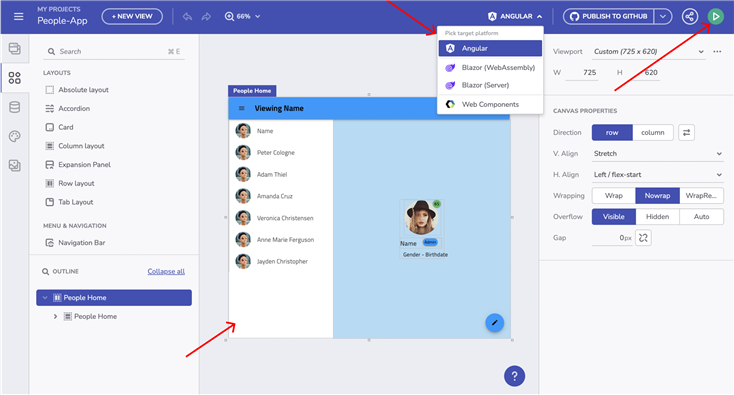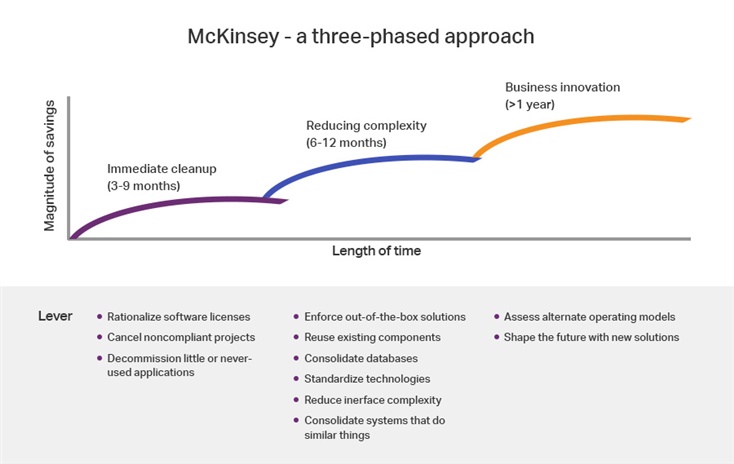
How Can Low-Code Tools Reduce Cost During Recession
The battle against inflation is a key concern for every business. But enterprise low-code platforms like App Builder can reduce costs during challenging times like these.
The software industry is currently in the clutches of a global recession. But the ongoing global economic downturn has shifted energy to establish new business models and software development processes, aiming at order-of-magnitude reductions in terms of IT and development costs.
But it doesn’t strictly mean cutting back on budgets only.
In these challenging for the industry times, often, CEOs and CTOs define their software development spending as a “black box”, but the returns are not always achieved in the expected or most beneficial way.
Why?
Because of implications like:
- Incomplete risk evaluation and mitigation
- Lack of flexibility imposed on different levels (DevOps, remote work environment, etc.)
- Low degree of automation
- Overlapping deadlines and an increasing number of projects
- Slow time to market
- Inefficient staffing models
- Inability to keep up with increasing user demands
- Incapability to handle the developer shortage crisis
- Sprinting back and forth between projects
Among all these factors, plus the high percentage of late delivery on projects, how does an organization reduce software development costs during a recession?
As Akis Sklavounakis, Senior Director Analyst at Gartner, highlights; “Investment in new application development is 17% of the total IT spend, making it a fruitful place to look for opportunities to cut costs, optimize spend or improve value.”
In other words, consolidate tooling from dozens or even hundreds of tools in some large enterprises to deliver significant cost savings.
Are automation and related technologies like our low-code App Builder the panacea then?
Seems like it.
Everyone Is Anxious About Inflation
The battle against inflation is a key concern for central banks, even with some predictions that global inflation rates will decrease in 2023. Yet, despite the slower growth pace, the IT market remains a bit more stable compared to other sectors. Software services and product development expenditures climbed by 9.6% and 6.2%, respectively. But the expense on hardware is estimated to have decreased by 5%.
All this drives investments in automation and low-code technology that can empower organizations to:
- Optimize their expenditures on products, people, processes, programs
- Streamline software development life cycle
- More easily adapt to the changing economic environment
- Score better ROI
Let’s visualize this with examples and see how using the App Builder platform in combination with a toolbox of UI controls and components like Ignite UI results in cost-effectiveness.
Example 1: Cost of a Single Team Member
In order for a programmer to “code” applications or a component, it costs X amount of money per month and per year. So, let’s do some calculations for the time to implement an app. Assuming an average salary of $120,000 per year (10K a month), developers cost between $50 and $60 per hour.
If a developer spends 3 hours a day, 3 days a week, for 4 weeks, on actually creating an app for different frameworks, with specific layouts, controls, and theming capabilities, this work amounts to $540 per week, which means $540 x 4 weeks = $2160. This is the monthly cost for a developer. And you need many, many developers (and designers, and testers, and documentation specialists) to build software.
However, if you purchase a low-code tool with UI components, the amount is significantly reduced. For example, tool X costs $1295 per year. Which is a little more than $100 per month compared to the monthly salary of one developer. Can you replace a team member for $100? No, absolutely not. What you gain is exponential delivery efficiency, resulting in overall cost reduction and higher, consistent delivery.
Things that are handled with low-code platforms:
- POCs
- Kickstarting implementation on a web framework like Angular/Blazor
- Implementation of functionalities like a web page with bindable lists/grids with data; site navigation with routing; login screen
- GitHub repository setup and CI setup
- Angular/Blazor application setup – installing dependencies and project configurations
The biggest value that the App Builder platform brings relates to both productivity and efficiency as well as to the easy switch from one framework to another (i.e. you can easily go from Angular to Blazor or Web Component app in a single click).
The example above doesn’t measure the value of produced code per day but the value of efficiency in a development process. This results in more quality code on top of what is provided, as well as a significant cost reduction in terms of altering the code.
Key things to consider:
- What would it cost me to build the same number of apps with and without the low-code platform?
- How long did it take to create most of the applications? What kind of energy is spent on maintaining and updating old applications?
- What would be the result if developers had more time to focus on mission-critical projects?
Example 2: Considering a Whole Team
(PM + UX Design + Development) * x Avg Cost/Hour Staff = Approximate Cost
Assuming an average salary for a PM+UX Designer + developer of $350,000 per year (30K a month). In this case, the cost is roughly $180 per hour.
Again, we consider an average of three hours * three times a week. We’ve calculated a hypothetical cost of implementation to 3 days * 3 hours * $180 = $1620 per week. For a month this means $1620 x 4 weeks = $6480. Compared to purchasing product X at a price of $1295 per year ($100 / month), your cost is $1.75 / day to add exponential efficiency to your team’s output.
Some of the consuming processes that are handled with the help of low-code platforms:
- Visual Design implementation
- Communication between the team – Sync on design, implement it, request new styles, change design, implement it again
- POCs
- Application flow creation
- Kickstarting implementation on a web framework like Angular, Blazor, or others.
- Implementation of functionalities like a web page with bindable lists/grids with data; site navigation with routing; login screen
- GitHub repository setup and CI setup
- Angular/Blazor application setup. Installing dependencies and project configurations
Key things to consider:
Time spent on UX is time not spent on development. Time spent figuring out how to make a column resizable in-app is time not spent on QA. Time testing the same resizable column is time not spent on developing formulas. You are saving expenses in every aspect of building and delivering software with low-code tooling.
How Can Low-Code Tools Reduce Cost During Recession
When it comes to low-code tools and their role in software development cost reduction, it’s important to point out that the primary goal is to achieve cost optimization – not simply to implement budget cuts.
What is the difference?
- Budget cuts aim at reducing spending. The downside here is it may have an inefficient and disproportionate impact on everything in the full product development life cycle – DesignOps, DevOps, people, and other tools.
- Cost optimization helps companies achieve less expense + greater business value + optimized processes. It is more strategic. And it has better long-term perspectives.
Here’s how it happens through the adoption of low-code tools like App Builder.
Leveraging a Proven Single Solution Across Multiple Departments and Fusion Teams
Having fewer tools in place means less maintenance and easier support from your IT team; quicker on-training of employees; digitalization; one subscription plan only and no need to use different plans for different tools. When all costs for application design and development are consolidated into a single platform, it results in fewer additional expenses.
Automation of Mundane and Repetitive Tasks Through Component Reusability

One other thing that low-code platforms are so great at is replacing manual tasks with automated processes. App Builder, for instance, integrates a full-featured toolbox, so you don’t need to invest money, time, and effort in creating in-house UI library. Instead, you can use out-of-the-box, reusable and customizable components with feature parity across technologies (Angular, Web Components, Blazor Server, Blazor WebAssembly), achieving about 80% faster development and time to market.
Code Preview and Production-Ready Code Generation

Low-code tools reduce costly error-prone hand-coding in areas like screen design, UX flows, theming, branding, data binding, deployment, and even GitHub integration. App Builder for example offers quicker transitioning from design-to-code, converting files in Sketch, Figma to pixel perfect code with the help of an integrated design system. And what’s more, there is no need for manual HTML & CSS tweaking which according to Gartner can take up to 60% of the application development time.
Time-Consuming POCs and Designer-Developer Handoffs Are Eliminated
Using low code tooling, you gain additional savings from the high cost of potential UI redesign and bug-fixing that always occurs post-deployment. Because you are prototyping and testing in the low-code tool, you can ensure customer acceptance before deployment, thus reducing code churn and the 10X cost of post-deployment bug fixes.
Promoting a More Flexible Enterprise Culture and Remote Work Environment + Invite Citizen Developers
Adapting a talent-anywhere approach is a great way to simultaneously keep up with it and save on IT costs, tackle the developer shortage, and democratize code. This lets companies take advantage of the growing pool of citizen developers, leaving experienced programmers to churn out complex application algorithms. In addition, they can also respond to a continuous disruptive demand-supply trend where the demand for more and more innovative solutions exceeds the availability of dev experts who can create them.
Switching to this also eliminates spending in areas that no longer fit the post-pandemic world. In this regard, a Gartner survey of 127 company leaders of HR, Legal and Compliance, Finance, and Real Estate reports that 82% of respondents intend to allow remote work some of the time. Whereas 47% intend to permit employees to work remotely full-time.
In the most practical sense, this will reduce the cost of renting or buying huge office spaces. In a more abstract sense, this will foster a different workplace culture that prioritizes collaboration and transparency.
Lower Total Cost of Ownership (TCO)
The total cost of ownership refers to the purchase price (i.e. short-term price) of a tool plus the costs of operation (long-term price) for the entire life span and the time the tool is in use. Typically, an IT company invests in different design tools, software development platforms, UI toolboxes, then analytics tools, team management systems, and so forth.
Low-code tools eliminate the need for that many tools while reducing costs on installation, transition costs, employee training, security testing, future upgrades, and more. How come? Because they work as a single source of truth and are able to build apps with a single code base that are more scalable, maintainable, testable, and easily deployable than any individual or team can guarantee.
Amid the economic crisis, IT companies are searching for every opportunity to rationalize product development costs and operations. That’s where low-code development fits in.
There is a great 3-phased approach suggested by McKinsey to achieve transformation and minimize disruption to the business that is very applicable to the current economic state and the way low-code platforms weigh in as game changers.

Undoubtedly, tools like App Builder are here to stay. In challenging times when cost reduction and optimization are a must, these technologies are capable of achieving cost efficiency, streamlining the software development life cycle, delivering proven ROI, and helping companies adapt to the dynamic economic environment.

